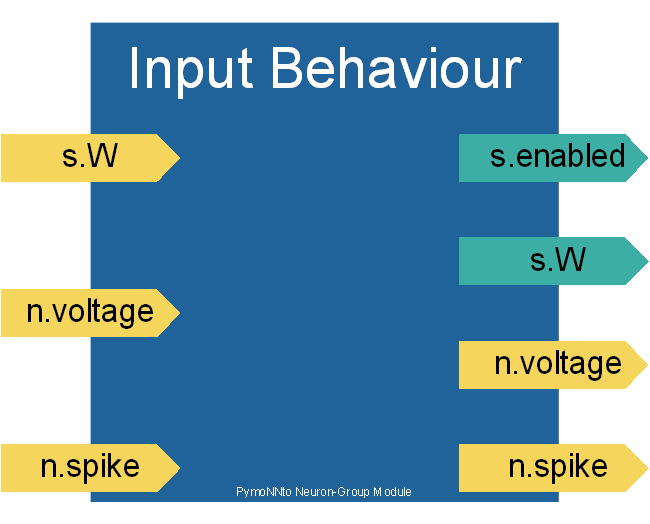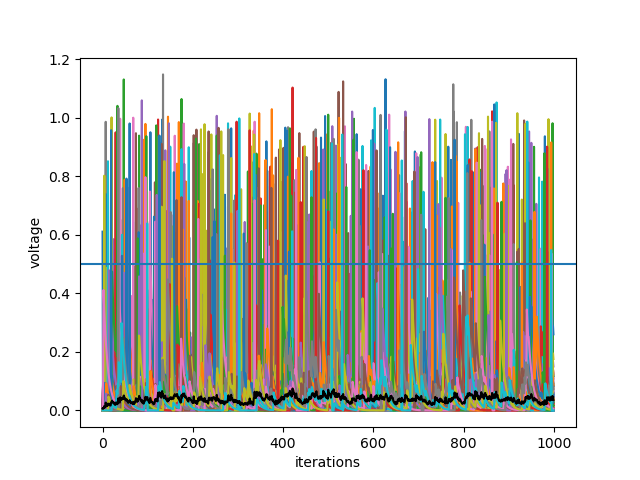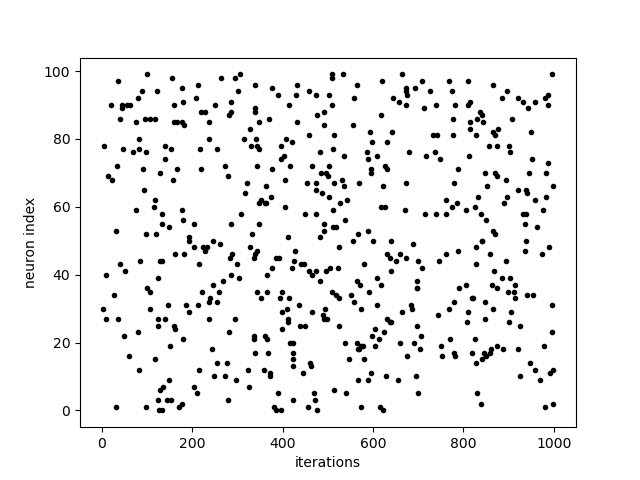Basic Code Structure
The following code creates a network of 100 neurons with recurrent connections and simulates them for 1000 iterations. What is still missing are some behaviour modules. This modules have to be passed to the NeuronGrop to definde what the neurons are supposed to do at each timestep.
from PymoNNto import *
My_Network = Network()
My_Neurons = NeuronGroup(net=My_Network, tag='my_neurons', size=100)
SynapseGroup(net=My_Network, src=My_Neurons, dst=My_Neurons, tag='GLUTAMATE')
My_Network.initialize()
My_Network.simulate_iterations(1000)
Behaviour
Each Behaviour Module has the following layout where set_variables is called when the Network is initialized, while
new_iteration is called repeatedly every timestep. neurons points to the parent neuron group the behaviour belongs to or some other parent object the beaviour is attached to.
In this example we define a variable voltage and a threshold. The activity-vector is initialized with 0 values for each neuron.
At each timestep a spike is created if the voltage is above the threshold value. After that, the voltage vector is decreased with factor 0.9 and random input is added.
When we combine the previous code blocks we can add the Basic_Behaviour to the NeuronGroup.
The number in front of each behaviour (1 and 9) have to be positive and determine the order of execution for each module inside and accross NeuronGroups.
To plot the neurons activity over time, we also have to create a Recorder. Here the voltage and the mean-voltage are stored at each timestep.
At the end the data is plotted via the tagging system (see tagging system section).
class Basic_Behaviour(Behaviour):
def set_variables(self, neurons):
neurons.voltage = neurons.get_neuron_vec()
self.threshold = 0.5
def new_iteration(self, neurons):
firing = neurons.voltage > self.threshold
neurons.spike = firing.astype(def_dtype) #spikes
neurons.voltage[firing] = 0.0 #reset
neurons.voltage *= 0.9 #voltage decay
neurons.voltage += neurons.get_neuron_vec('uniform',density=0.01) #noise
...
# Add behaviour to NeuronGroup
My_Neurons = NeuronGroup(net=My_Network, tag='my_neurons', size=100, behaviour={
1: Basic_Behaviour(),
9: Recorder(tag='my_recorder', variables=['n.voltage', 'np.mean(n.voltage)'])
})
...
import matplotlib.pyplot as plt
plt.plot(My_Network['n.voltage', 0, 'np'][:,0:10])
plt.plot(My_Network['np.mean(n.voltage)', 0], color='black')
plt.axhline(My_Neurons['Basic_Behaviour', 0].threshold, color='black')
plt.show()
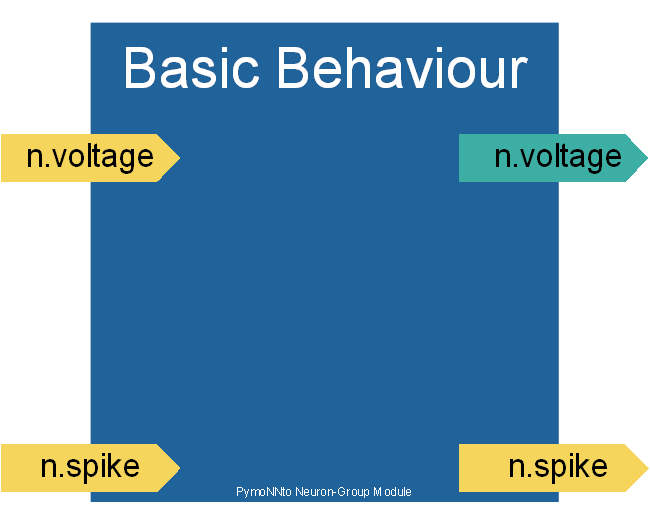
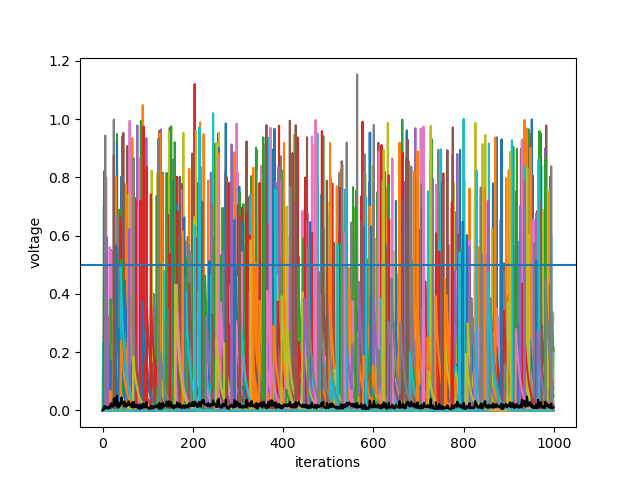
Synapses and Input
We can add more behaviour modues to make the activity of the neurons more complex. Here the module Input_Behaviour is added.
In set_variables the synapse matrix is created, which stores one weight-value from each neuron to each neuron.
The Function new_iteration defines how the information is propagated to each neuron (dot product) and adds some term for random input.
The for loops are not neccessary here, because we only have one SynapseGroup.
This solution, however, also works with multiple Neuron- and SynapseGroups.
With synapse.src and synapse.dst you can access the source and destination NeuronGroups assigned to a SynapseGroup.
Here we also add an event recorder to plot the spikes of the NeuronGroup.
from PymoNNto import *
class Basic_Behaviour(Behaviour):
...
class Input_Behaviour(Behaviour):
def set_variables(self, neurons):
for synapse in neurons.afferent_synapses['GLUTAMATE']:
synapse.W = synapse.get_synapse_mat('uniform',density=0.1)
synapse.enabled = synapse.W > 0
def new_iteration(self, neurons):
for synapse in neurons.afferent_synapses['GLUTAMATE']:
neurons.voltage += synapse.W.dot(synapse.src.spike)/synapse.src.size*10
My_Network = Network()
My_Neurons = NeuronGroup(net=My_Network, tag='my_neurons', size=100, behaviour={
1: Basic_Behaviour(),
2: Input_Behaviour(),
9: Recorder(tag='my_recorder', variables=['n.voltage', 'np.mean(n.voltage)']),
10: EventRecorder(tag='my_event_recorder', variables=['n.spike'])
})
my_syn = SynapseGroup(net=My_Network, src=My_Neurons, dst=My_Neurons, tag='GLUTAMATE')
My_Network.initialize()
My_Network.simulate_iterations(1000)
#plotting:
import matplotlib.pyplot as plt
plt.plot(My_Network['n.voltage', 0, 'np'][:,0:10])
plt.plot(My_Network['np.mean(n.voltage)', 0], color='black')
plt.axhline(My_Neurons['Basic_Behaviour', 0].threshold, color='black')
plt.xlabel('iterations')
plt.ylabel('voltage')
plt.show()
plt.plot(My_Network['n.spike.t', 0], My_Network['n.spike.i', 0], '.k')
plt.xlabel('iterations')
plt.ylabel('neuron index')
plt.show()
